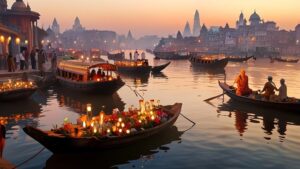Understanding the Maha Kumbh at Kashi Vishwanath Temple
The Maha Kumbh at the revered Kashi Vishwanath Temple in Varanasi is a spiritual congregation that attracts millions of devotees. However, the immense footfall brings with it numerous challenges.
Challenges Faced During the Pilgrimage
1. Overcrowding Issues
With over 2 crore pilgrims visiting the temple since the beginning of Maha Kumbh, managing crowd flow remains a great concern.
2. Infrastructure Pressure
The local infrastructure including roads, sanitation, and accommodation struggles to cope with the overwhelming number of devotees.
3. Environmental Impact
- Increased pollution from human activities
- Waste accumulation due to high footfall
- Strain on the sacred Ganga river
4. Security Challenges
Ensuring safety amidst such a massive gathering is a daunting task for local authorities.
Root Causes Behind These Challenges
| Cause | Impact |
|---|---|
| Unprecedented Pilgrim Turnout | Strains temple management & local administration |
| Limited Resources | Hampers effective crowd control |
| Lack of Awareness | Pilgrims unaware of proper routes, facilities |
| Unregulated Tourism | Commercial exploitation, excessive waste |
Repercussions of the Issue
Health Concerns
- High risk of stampedes
- Unhygienic conditions causing illness
- Spread of contagious diseases
Religious Disruptions
Overcrowding affects the spiritual experience as devotees struggle to get darshan.
Financial Losses
Local businesses, despite increased sales, bear the brunt of operational challenges and damages.
Stakeholders and Their Perspectives
Pilgrims’ Perspective
Many devotees believe that despite hardships, visiting Kashi Vishwanath Temple is a once-in-a-lifetime experience.
Local Business Owners
- Increase in income due to tourism
- Operational difficulties due to infrastructure stress
Government & Authorities
Officials aim to regulate the crowd through better planning and technology-driven solutions.
Environmentalists
Advocates stress the need for eco-friendly measures to protect the holy Ganga and surrounding areas.
Kashi Vishwanath Temple & Maha Kumbh Pilgrimage – Frequently Asked Questions
1. Where is Kashi Vishwanath Temple located?
Kashi Vishwanath Temple is situated in Varanasi, Uttar Pradesh, India, along the western bank of the sacred Ganges River.
2. What is the significance of Kashi Vishwanath Temple?
The temple is one of the 12 Jyotirlingas and is dedicated to Lord Shiva. It is considered extremely sacred in Hinduism.
3. What are the temple timings for darshan?
The temple is open for devotees from 3:00 AM to 11:00 PM daily, with different Aarti and puja ceremonies throughout the day.
4. What is the best time to visit Kashi Vishwanath Temple?
The best time to visit is early morning or late evening, particularly during festivals like Mahashivratri for a grand spiritual experience.
5. Can non-Hindus visit the temple?
Non-Hindus are generally not allowed inside the sanctum, but they can explore the surrounding temple complex and experience its spirituality.
6. What is the significance of the Maha Kumbh Mela?
Maha Kumbh Mela is the world’s largest spiritual gathering, held every 12 years, where millions take a holy dip for spiritual purification.
7. Where is the next Maha Kumbh Mela going to be held?
The next Maha Kumbh Mela will be held in Prayagraj, Uttar Pradesh, where devotees gather for the sacred confluence of rivers.
8. What are the main rituals at Kashi Vishwanath Temple?
The main rituals include Rudrabhishek, Mangala Aarti, Bhog Aarti, and the Ganga Aarti held at Dashashwamedh Ghat nearby.
9. Are there any special arrangements for VIP darshan?
Yes, the temple offers special VIP passes for quicker darshan, which can be booked online or at the temple premises.
10. What is the dress code for visiting the temple?
Traditional attire is suggested, with men wearing dhotis and women wearing sarees or salwar kameez as a mark of respect.
11. How can I reach Kashi Vishwanath Temple?
The temple is accessible via Varanasi Airport (26 km away), Varanasi Junction railway station, and local transport like autos and rickshaws.
12. Are mobile phones and cameras allowed inside the temple?
No, mobile phones, cameras, leather items, and electronic devices are strictly prohibited inside the temple premises.
13. How can I book online darshan or puja services?
Online booking for darshan and puja services is available through the official Kashi Vishwanath Temple website and authorized portals.
14. Is there a specific queue system for darshan?
Yes, multiple queue options exist, including general, VIP, and express darshan queues to manage the heavy influx of devotees.
15. What are the nearby attractions in Varanasi?
Tourists can visit Dashashwamedh Ghat, Sankat Mochan Hanuman Temple, Sarnath, Manikarnika Ghat, and the Banaras Hindu University.
16. What is the spiritual importance of taking a bath in the Ganges?
Bathing in the Ganges is believed to cleanse sins and help attain Moksha or liberation from the cycle of reincarnation.
17. Is accommodation available near Kashi Vishwanath Temple?
Yes, there are numerous budget hotels, guest houses, and dharamshalas near the temple for devotees’ convenience.
18. What food options are available around the temple?
Varanasi offers delicious vegetarian food, including kachori sabzi, chaat, malaiyo, and world-famous Banarasi paan.
19. Are there any restrictions for foreign tourists visiting the temple?
Foreign tourists may have restricted access to the sanctum but are welcome to explore the surrounding temple complex.
20. Why is Varanasi called the spiritual capital of India?
Varanasi is the oldest continuously inhabited city, known for its spiritual vibes, sacred ghats, and devotion to Lord Shiva.
Legal Disclaimer: The information provided in this FAQ section is for general guidance and religious awareness purposes only. Temple timings, rituals, and rules may change, and visitors are advised to check official sources before making any plans. We do not claim any authority over religious matters. Please consult official temple management for the latest updates.




